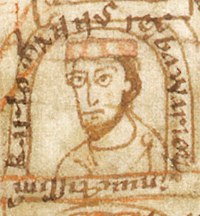|
Anselm Of Besate
Anselm of Besate (''Anselmus Peripateticus'', "Anselm the Peripatetic") was an 11th-century churchman and rhetorician. Anselm was born at Besate shortly after the year 1000 to a notable local family. He describes his genealogy in detail. He was related on his father's side to Bishops Sigifred of Piacenza, John II of Lucca and Cunibert of Turin, and to Archbishop John X of Ravenna. His mother belonged to the House of Arsago, through which he was related to Archbishop Arnulf II of Milan and Bishop Landulf II of Brescia. Anselm received his education in Padua and Reggio, and became attached to the church of Milan. He later served in the chapel of the Emperor Henry III (reigned 1046–1056). Around 1047, he composed the ''Rhetorimachia'' (or ''De materia artis'') and dedicated it to Henry III. It is one of the first works on rhetoric to appear in western Europe after Rabanus Maurus' ''De institutione clericorum'' of 819. It is a treatise in three books, ostensibly a letter to hi ... [...More Info...] [...Related Items...] OR: [Wikipedia] [Google] [Baidu] |
Rhetorician
Rhetoric () is the art of persuasion, which along with grammar and logic (or dialectic), is one of the three ancient arts of discourse. Rhetoric aims to study the techniques writers or speakers utilize to inform, persuade, or motivate particular audiences in specific situations. Aristotle defines rhetoric as "the faculty of observing in any given case the available means of persuasion" and since mastery of the art was necessary for victory in a case at law, for passage of proposals in the assembly, or for fame as a speaker in civic ceremonies, he calls it "a combination of the science of logic and of the ethical branch of politics". Rhetoric typically provides heuristics for understanding, discovering, and developing arguments for particular situations, such as Aristotle's three persuasive audience appeals: logos, pathos, and ethos. The five canons of rhetoric or phases of developing a persuasive speech were first codified in classical Rome: invention, arrangement, style, mem ... [...More Info...] [...Related Items...] OR: [Wikipedia] [Google] [Baidu] |
Notker Labeo
Notker Labeo (c. 950 – 28 June 1022), also known as Notker the German ( la, Notcerus Teutonicus) or Notker III, was a Benedictine monk and the first commentator on Aristotle active in the Middle Ages. "Labeo" means "the thick-lipped one". Later he was named ''Teutonicus'' in recognition of his services to the German language. Life and career He was born about 950, from a noble family of Thurgau, and he was a nephew of Ekkehard I, the poet of '' Waltharius''. He went to the Abbey of Saint Gall when only a boy, and there acquired a vast and varied knowledge by omnivorous reading. After finishing his education, he continued in the abbey as a teacher and then head of the school under abbot Burckhard II. His contemporaries admired him as a theologian, philologist, mathematician, astronomer, connoisseur of music, and poet. He tells of his studies and his literary work in a letter to Bishop Hugo of Sitten (998–1017), and we also know of his activities through texts from his pupil ... [...More Info...] [...Related Items...] OR: [Wikipedia] [Google] [Baidu] |
Rhetoricians
Rhetoric () is the art of persuasion, which along with grammar and logic (or dialectic), is one of the three ancient arts of discourse. Rhetoric aims to study the techniques writers or speakers utilize to inform, persuade, or motivate particular audiences in specific situations. Aristotle defines rhetoric as "the faculty of observing in any given case the available means of persuasion" and since mastery of the art was necessary for victory in a case at law, for passage of proposals in the assembly, or for fame as a speaker in civic ceremonies, he calls it "a combination of the science of logic and of the ethical branch of politics". Rhetoric typically provides heuristics for understanding, discovering, and developing arguments for particular situations, such as Aristotle's three persuasive audience appeals: logos, pathos, and ethos. The five canons of rhetoric or phases of developing a persuasive speech were first codified in classical Rome: invention, arrangement, style, mem ... [...More Info...] [...Related Items...] OR: [Wikipedia] [Google] [Baidu] |
11th-century Italian Roman Catholic Theologians
The 11th century is the period from 1001 ( MI) through 1100 ( MC) in accordance with the Julian calendar, and the 1st century of the 2nd millennium. In the history of Europe, this period is considered the early part of the High Middle Ages. There was, after a brief ascendancy, a sudden decline of Byzantine power and a rise of Norman domination over much of Europe, along with the prominent role in Europe of notably influential popes. Christendom experienced a formal schism in this century which had been developing over previous centuries between the Latin West and Byzantine East, causing a split in its two largest denominations to this day: Roman Catholicism and Eastern Orthodoxy. In Song dynasty China and the classical Islamic world, this century marked the high point for both classical Chinese civilization, science and technology, and classical Islamic science, philosophy, technology and literature. Rival political factions at the Song dynasty court created strife amongst th ... [...More Info...] [...Related Items...] OR: [Wikipedia] [Google] [Baidu] |
.jpg)
